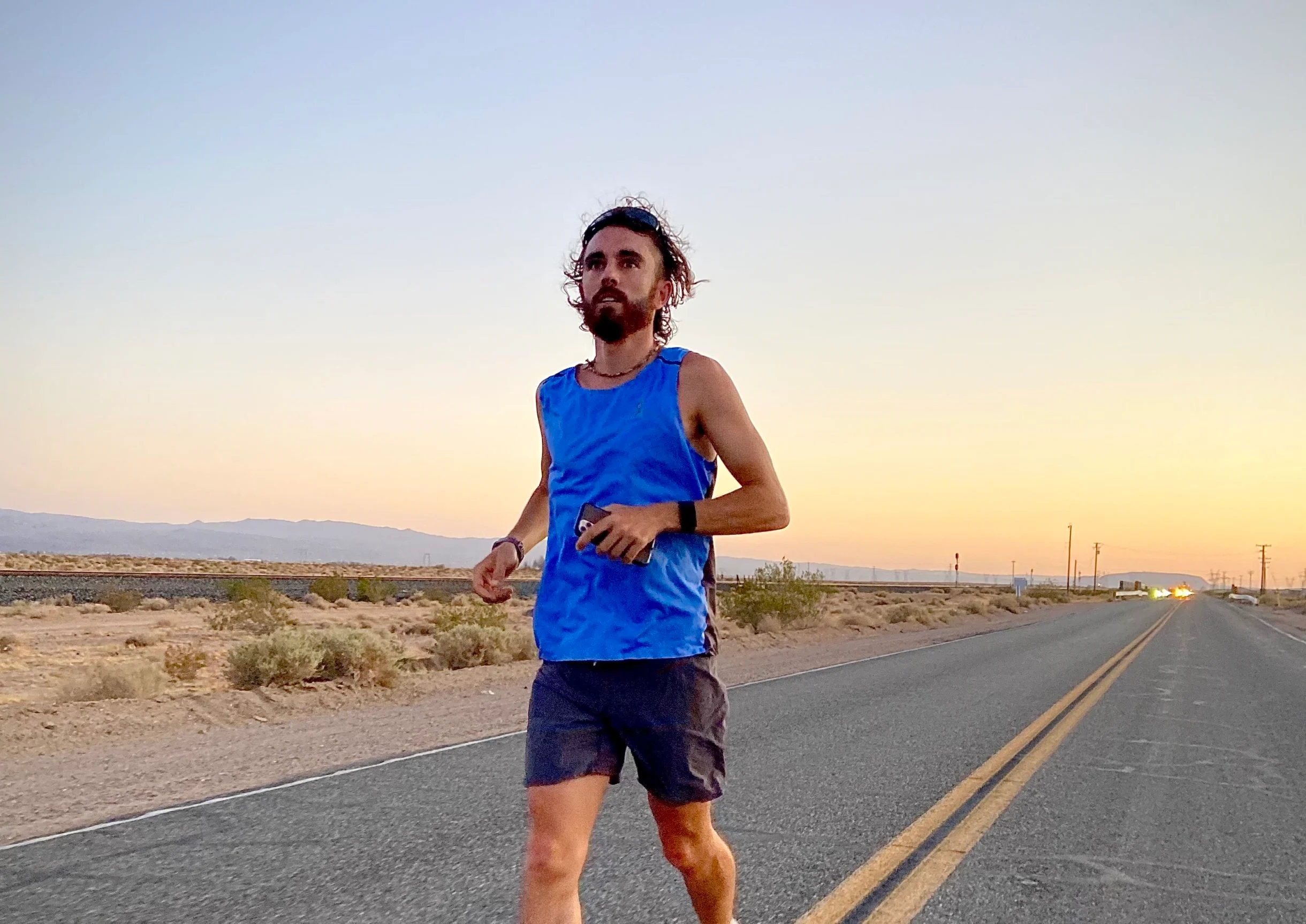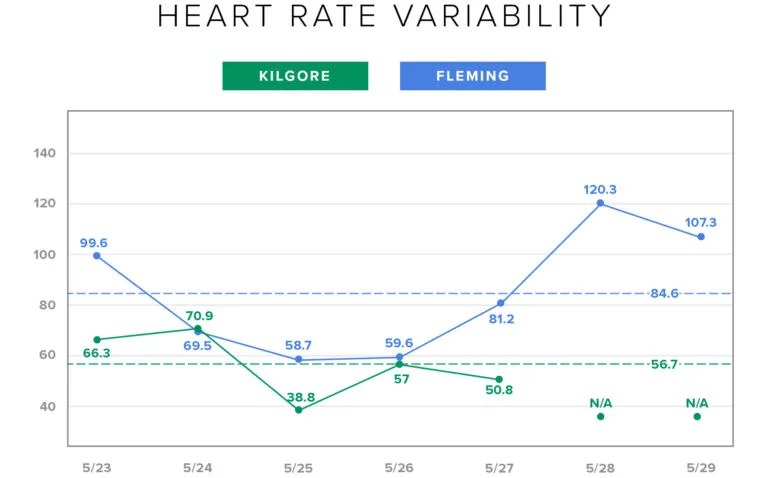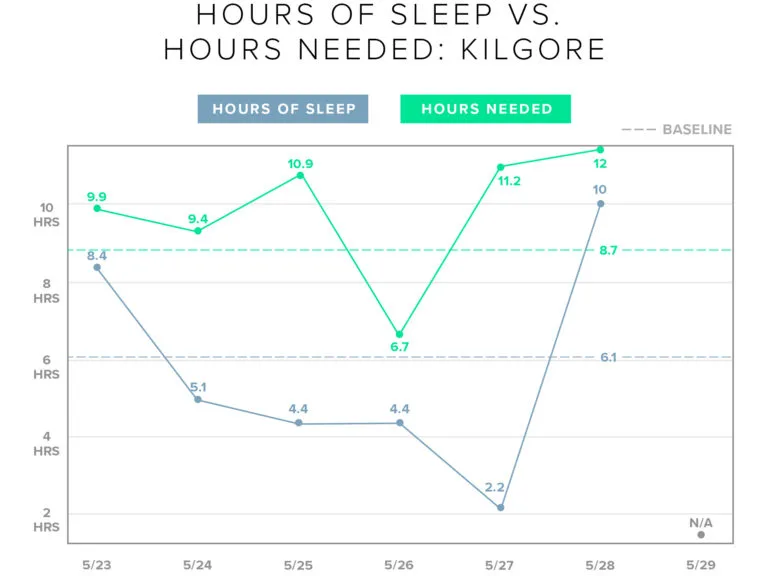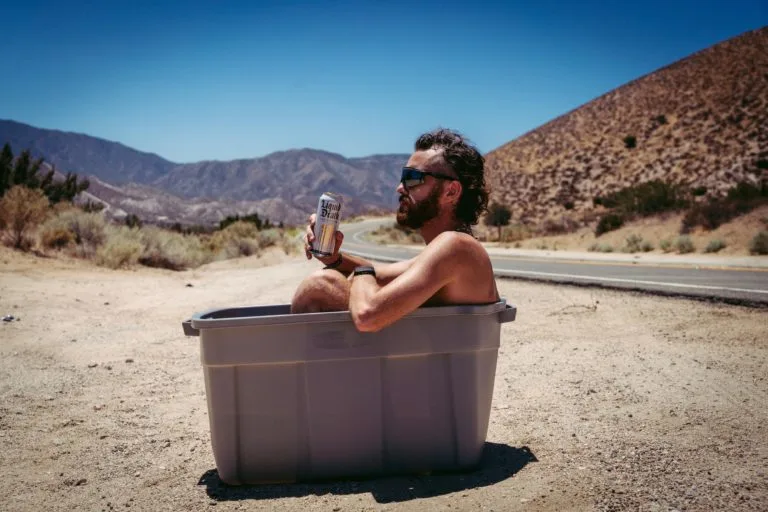Topics
- Article
- Member Stories
- Running
The Speed Project: Tracking Two Ultrarunners’ 340-Mile Trek Across the Desert

We examine WHOOP data from The Speed Project, looking at strain, sleep, recovery, HRV and more during an epic 340-mile run from the California coast all the way to Las Vegas, on May 24-28, 2021.
In the fall of 2019, ultrarunner Margot Fleming got a text from a friend asking for a particularly unique inquiry. That friend was Nils Arend, co-founder of The Speed Project (TSP), a 340-mile unsanctioned relay race from Santa Monica to Las Vegas, and he wanted to know if Margot would be interested in running the full thing, completely solo. Without hesitation, Margot agreed and hired coach Lisa Batchen to formulate a realistic training plan. While the endeavor was certainly an extreme challenge and maybe a little crazy, she had a reputable running history with 40 marathons and 8 ultras under her belt and felt the event was attainable. She’d also been using WHOOP for a little over a year to better understand her recovery from high mileage. Only a few months before TSP this year (it'd been pushed back from 2020), ultrarunner David Kilgore heard from Arend about the solo journey, which could be anywhere from 300 to 340 miles depending on the scouted route. According to Kilgore, it was “not planned,” but he decided, “Hell yeah, let’s do it!” For Kilgore, a known personality in the world of running who ran the relay portion of TSP back in 2018 with Tracksmith, attempting the solo mission was not unlike the similar niche, extreme events he’d done before. This, however, would prove to be one of the most challenging feats he’d taken on to date.
What is The Speed Project?
It all started as a lofty idea, a musing over drinks back in 2013. “What if we ran from LA to Vegas?” Together, Nils and a team of 5 others including renowned coach Blue Benadum made plans to run a relay from the Santa Monica pier to the iconic Las Vegas sign by any means necessary. It would mean renting an RV, scouting out routes in Death Valley, and mentally preparing themselves for very little sleep. Thus the mantra was born: “No Rules” and “No Spectators.” There was no designated route and no guarantee. Five years later it’s become the official-unofficial race of the modern-day distance runner, purely by word of mouth, with the help of some beautiful Instagram photography. You can’t sign up (you have to be invited), you have to supply your own support crew, and you’re pretty much on your own as you plan your trek across the desert. It’s been likened to Hunter S. Thompson’s novel Fear and Loathing in Las Vegas, a surreal, drug-fueled car trip across the desert complete with philosophical banter, spiritual awakenings, and countercultural commentary. The Speed Project is a little bit like that, minus the drugs. You’re breaking down the body through physical exertion while achieving spiritual enlightenment along the way.

Prioritizing Sleep and Recovery Before The Speed Project
How do you prime your body for peak performance leading up to an event that is going to destroy your recovery day after day? First, you have to do the training and get the miles under your belt. For Margot and David, two skilled runners who regularly log anywhere from 50 to 100 miles per week, cardiovascular fitness wasn’t the issue. They tapered before the race, focused on sleep and nutrition, and took care of any nagging ailments well before the race date through massage, chiro, and acupuncture. For this event, recovery and preparedness were far more mental than physical. “A lot of the prep work really had to do with the logistics of the route, supplies that would be needed, and aligning with my team. I went into it pretty calm, but excited. This was a new challenge and road that I have never been down before. My plan was really to listen to my body and be adaptable and learn along the way,” explained Kilgore. For Margot, it was all about getting into that “flow.” Trusting her body, having confidence, and knowing her body. In terms of recovery, people underestimate the benefit of mental clarity. Research shows that anxiety and stress have a negative relationship with heart rate variability (HRV). A high HRV typically correlates with greater cardiovascular fitness and may indicate you are more resilient to stress. It was obvious that 340 miles under the unforgiving, blazing sun would be physically challenging, but without a calm mind and heart, it might be virtually impossible.
A Tale of Recovery, Strain, and (Lack of) Sleep
On Monday, May 24th at 4 am, David and Margot took off from the Santa Monica pier along with a few other solo runners. For the next several days, they logged nearly 80-100 miles per day, passing through Los Angeles National Forest, Death Valley, and the Mojave Desert. As expected, their bodies were exhausted, burnt, and beat up, which was very apparent in their WHOOP data. David finished TSP in 4 days (which accounts for the N/A data in charts that follow), while Margot completed it in 6.

David and Margot's daily HRV, beginning the day before they started running, as well as their averages for the week.
“The biggest challenges of the journey were definitely the heat during the day with not a cloud in the sky, and going into uncharted territory. I ended up having to bushwack for about 50 miles and ate it in the middle of the night on some barbed wire entwined with the sand. It dropped me down a 6-8 foot sandy ledge where I landed on a rock with my left quad. I grinded through about 10 more night miles after and then went to bed. When I woke up that was probably my lowest moment,” said Kilgore. This happened about 48 hours into the race, or the halfway point for David. You can see an immediate drop in WHOOP recovery for both runners once the race began on 5/24. This was likely due to lack of sleep from having to wake up at 3 am for a 4 am start time. Margot only got 3.1 hours of sleep and woke up with a 31% recovery, while Kilgore slept for 5.1 hours and woke up at 53% (see sleep charts below).

There was a dIp in recovery for both runners when the race started. While David’s continued to drop, Margot's actually increaseD over the last few days as her body adapted to the elements.
According to both runners, sleep was probably the most important thing they could focus on during TSP. The goal of TSP is to do it fast, which means you’re not sleeping through the night. Instead, you take power naps throughout the day, and your full “sleep” is maybe a few hours. This allows the runners to keep going at a rhythmic, albeit draining, pace. Both runners nearly maxed out on their WHOOP strain each day at 20.7, logging up to 10 activities per day with each segment of running. The charts below specify how many hours of sleep WHOOP told them they needed (green), versus the total amount they were able to get (blue).

The amount of sleep David got each night compared to the amount his body needed.

Margot's hours of sleep each night compared to what she needed.
What’s interesting to note is how Margot bounced back after a few days with her recovery and HRV. While sleep was still at a minimum, there was a small spike in both metrics on Day 4 with a 44% recovery (up from 23%), and they continued to improve over the next few days. On her final day of the race she had a 67% recovery in the green. It’s a phenomenon we’ve seen before in some athletes taking on immense strain for days on end, coincidentally also in a recent 700-mile bike ride through Death Valley. This may seem counterintuitive, but a deeper dive into her data and understanding of human physiology tells a unique story. Margot’s sleep efficiency and consistency during this time far exceeded David’s, which meant she was getting more quality sleep at more consistent intervals. “I prioritized getting to sleep by 10-11 pm each night for my sake and my crew’s sake,” she explained. She also prioritized recovery modalities including ice baths for her legs and compression sleeves. Even though David’s data showed poorer recovery and sleep quality compared to Margot, it wasn’t for a lack of trying. “I learned a lot from the first few days on prioritizing recovery and sleep,” he said. “I have never had to sleep before in a race, and man does it help a ton! I never felt like I grasped the importance of sleep even before running TSP. Each time my legs felt completely flat or exhausted, I could nap for a few hours and it was like they were better just like that. Of course not back to 100%, but exponentially better.” “I usually felt like I slept a few more hours than it said I did, so I must not have been getting as good of sleep as I thought, which is good to know,” added David.

“I felt so raw and really alive.”
The point of The Speed Project is to push the mind and body to unconventional places, bordering on an alternate, surreal reality. A majority of the time you’re in a state of fight or flight, battling the elements and making quick decisions to adapt to your surroundings. The point of The Speed Project is to be as uncomfortable as possible. If there was anything grounding and objective about the experience, you can point to the data. WHOOP added a new component to the event, offering hard numbers and straightforward metrics to help the runners better understand their bodies. For Margot and David, the question was never “How can I focus on rest?” but instead, “How can I make the most of the situation I’m in?” And oftentimes, that’s what true performance is all about--optimizing what you are given and taking each day as it comes.